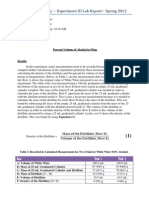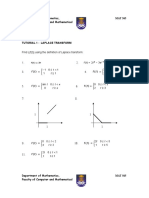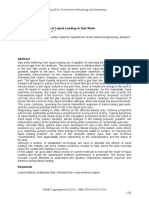Assignment#3
Assignment#3
Uploaded by
Amit SinghCopyright:
Available Formats
Assignment#3
Assignment#3
Uploaded by
Amit SinghOriginal Title
Copyright
Available Formats
Share this document
Did you find this document useful?
Is this content inappropriate?
Copyright:
Available Formats
Assignment#3
Assignment#3
Uploaded by
Amit SinghCopyright:
Available Formats
Assignment #3
EC-202: Signals and Systems
Q.1) Consider the following signals defined as
t
A sin for 0 t T
(i) xt T
x t T
elsewhere
2t T
A sin for 0 t
T 2
xt 0
T
(ii) for t T
2
x t T elsewhere
T
A 0t
4
A T
t
3T
(iii) xt 4 4
3T
A t T
4
x t T elsewhere
4A T
T tA 0t
2
(iv) xt t 3 A
4A T
t T
T 2
x t T elsewhere
For all signals described above
2
(a) If the signal is expressed as () = = exp ( ), determine for all
values of = 0, 1, 2, 3, ..
(b) Using the results of part (a), determine 0 , and for = 0, 1, 2, 3, .. when the
2 2
signal is expressed as () = 0 +
=1 ( ) + =1 ( )
(c) Using the results of part (a), determine 0 , and for = 0, 1, 2, 3, .. when the
2
signal is expressed as () = 0 + =1 ( + )
Q.2) A periodic signal xt is expressed by the following Fourier series:
xt 3 cos t sin 5t 2 cos 8t
6 3
(a) Sketch the amplitude and phase spectra for the trigonometric series.
(b) By inspection of spectra in part (a), sketch the exponential Fourier series spectra.
(c) By inspection of spectra in part (b), write the exponential Fourier series for xt .
(d) Show that the series found in part (c) is equivalent to the trigonometric series for xt .
Q.3) Evaluate the Fourier transform of the damped sinusoidal wave
g t exp t sin 2f ct u t where u t is the unit step function.
Q.4) Determine the Fourier transform of a Gaussian pulse defined as xt e t . Plot both xt
2
and X .
Q.5) The Fourier transform of a signal g t is denoted by G f . Prove the following properties
of the Fourier transform:
(a) If a real signal g t is an even function of time t , the Fourier transform G f is purely real.
If a real signal g t is an odd function of time t , the Fourier transform G f is purely imaginary.
n
j n
(b) t g t
n
G f , where G n f is the nth derivative of G f with respect to f .
2
n
j n
(c) t n g t dt
G 0
2
(d) g 1 t g 2 t G G
1
2 f d
(e) g 1 t g 2 t dt G f G
1
2 f df where ( ) represents complex conjugate.
Q.6) The Fourier transform of the triangular pulse xt in Fig.1 is expressed as
X
2
1
e j
je j 1 . Use this information, and the time-shifting and time-scaling
properties, to find the Fourier transforms of the signals xi t (i=1,2,3,4) shown in Fig.1.
You might also like
- Solution Manual Fox and Mcdonald S Introduction To Fluid Mechanics 8th Edition PDFDocument5 pagesSolution Manual Fox and Mcdonald S Introduction To Fluid Mechanics 8th Edition PDFAmit SinghNo ratings yet
- Investigatory Project On LDRDocument17 pagesInvestigatory Project On LDRAmit Singh75% (251)
- Astm E376 11 PDFDocument5 pagesAstm E376 11 PDFsergio100% (1)
- Experiment III Lab Report (Alcohol in Wine)Document6 pagesExperiment III Lab Report (Alcohol in Wine)Clayton VerBerkmös50% (2)
- Full Scale AnalysisDocument43 pagesFull Scale Analysispaulogud6170No ratings yet
- Assignment#2Document2 pagesAssignment#2vaishnaviNo ratings yet
- GM Signal&systemDocument93 pagesGM Signal&systemBhaskar SharmaNo ratings yet
- Fourier Series NfcietDocument11 pagesFourier Series Nfcietapi-19788618No ratings yet
- Continuous Time Fourier Transform - Practice Sheet 01Document8 pagesContinuous Time Fourier Transform - Practice Sheet 01Sahil SrivastavaNo ratings yet
- Signal & System WB SolutionsDocument226 pagesSignal & System WB SolutionsCHANDRIMA UPADHYAYNo ratings yet
- problem_booklet-FinalDocument9 pagesproblem_booklet-Finalyousif haddaNo ratings yet
- Assignment 3aDocument4 pagesAssignment 3aShahzaib NadeemNo ratings yet
- Assignment 3Document4 pagesAssignment 3AnasNo ratings yet
- Tutorial On EE320Document2 pagesTutorial On EE320Nikhil BagriNo ratings yet
- 2203BPS - Final Exam2009 - Solutions (1) 2Document7 pages2203BPS - Final Exam2009 - Solutions (1) 2samNo ratings yet
- Ee320a Tut1Document2 pagesEe320a Tut1mohit kumarNo ratings yet
- Tut1 PDFDocument2 pagesTut1 PDFNitish DeshpandeNo ratings yet
- Fourier Transform PropertiesDocument1 pageFourier Transform PropertiessightlesswarriorNo ratings yet
- EE320 Tut 1Document8 pagesEE320 Tut 1Ruchika WaskleNo ratings yet
- Reconstruction PDFDocument13 pagesReconstruction PDFRamaDinakaranNo ratings yet
- EE320A Tutorial 2Document2 pagesEE320A Tutorial 2mohit kumarNo ratings yet
- Laplace Tutorial 1,2,3Document3 pagesLaplace Tutorial 1,2,3Syafiq FauziNo ratings yet
- Week04Module03 FourierTransformsDocument13 pagesWeek04Module03 FourierTransformsrra127No ratings yet
- Past Year Final Question (20092010 (2) )Document12 pagesPast Year Final Question (20092010 (2) )Ton ElyNo ratings yet
- Assignment 1Document16 pagesAssignment 1secidih495No ratings yet
- Lamia Abusedra Dr. Linear Systems EE311: Homework No. 1Document2 pagesLamia Abusedra Dr. Linear Systems EE311: Homework No. 1Ĥmăđę HmNo ratings yet
- Tutorial 7 NCB 10103 (Mathematics For Engineers 1)Document2 pagesTutorial 7 NCB 10103 (Mathematics For Engineers 1)aNo ratings yet
- Fourier Series PresentationDocument81 pagesFourier Series PresentationRajithNimali100% (2)
- Convolution For Discrete and Continuous Time SignalsDocument41 pagesConvolution For Discrete and Continuous Time SignalsnajlaNo ratings yet
- Fourier Series Expansion of Periodic Signal: (With Period of T)Document45 pagesFourier Series Expansion of Periodic Signal: (With Period of T)Khaaliq DeJanNo ratings yet
- Digital CommunicationDocument105 pagesDigital CommunicationSabarinathNo ratings yet
- Practica N2Document3 pagesPractica N2John Mitchell López CalderónNo ratings yet
- S&S L5Document77 pagesS&S L5Aalaa Hussein HamidNo ratings yet
- Signals - Systems KSTDocument8 pagesSignals - Systems KSTShubhankar PalNo ratings yet
- ADCS Assignment I ADocument3 pagesADCS Assignment I ASwastik DashNo ratings yet
- Dada La Señal No Periódica G (T)Document27 pagesDada La Señal No Periódica G (T)Marko Chambi ColqueNo ratings yet
- Analog and Digital I/Q ModulationDocument16 pagesAnalog and Digital I/Q ModulationRui CarvalhoNo ratings yet
- Tutorial 4Document5 pagesTutorial 4Nornis DalinaNo ratings yet
- Unit 6.4 and 6.5 HW KeyDocument4 pagesUnit 6.4 and 6.5 HW KeyOmar AshrafNo ratings yet
- Representation of Bandpass SignalsDocument10 pagesRepresentation of Bandpass SignalsManoj GowdaNo ratings yet
- Chapter 4. Filtering in The Frequency Domain (1/2)Document34 pagesChapter 4. Filtering in The Frequency Domain (1/2)Ayoub MohammedNo ratings yet
- Generalized Fourier SeriesDocument8 pagesGeneralized Fourier Seriesjeffrey denenbergNo ratings yet
- MA310 - Laplace Transforms Problems - Set 1 - 2023 - 24Document3 pagesMA310 - Laplace Transforms Problems - Set 1 - 2023 - 24darlingtonsakala52No ratings yet
- HW 1Document3 pagesHW 1Zero ChengNo ratings yet
- Random Variable and Random Process - Practice Sheet 02Document6 pagesRandom Variable and Random Process - Practice Sheet 02amitprajapatieceNo ratings yet
- L3: Linear, Time-Invariant (LTI) Systems and Linear DistortionDocument25 pagesL3: Linear, Time-Invariant (LTI) Systems and Linear DistortionHunter VerneNo ratings yet
- Fourier Series Notes (New)Document46 pagesFourier Series Notes (New)Shashank SinghNo ratings yet
- Vector Valued Functions: MATH23 Multivariable CalculusDocument12 pagesVector Valued Functions: MATH23 Multivariable CalculusRyan Jhay YangNo ratings yet
- 3.fourier Series - Gibbs PhenomenaDocument5 pages3.fourier Series - Gibbs PhenomenaSPECIFIED With SIMFLIFICATIONNo ratings yet
- 02 Fourier Theory and Communication SignalsDocument39 pages02 Fourier Theory and Communication Signals張思思No ratings yet
- Fourier SeriesDocument46 pagesFourier SeriesSiddhanth VenugopalNo ratings yet
- Digital Coding of Analog Signal Ut1Document36 pagesDigital Coding of Analog Signal Ut1Abhimanyu SinghNo ratings yet
- Fourier Series Notes PDFDocument39 pagesFourier Series Notes PDFsudarshan poojaryNo ratings yet
- Fourier Relations in Optics: Near Field Far Field Frequency Pulse Duration Frequency Coherence LengthDocument54 pagesFourier Relations in Optics: Near Field Far Field Frequency Pulse Duration Frequency Coherence LengthLuis MesaNo ratings yet
- SNS Practice Problem 1Document3 pagesSNS Practice Problem 1OvaisAkhterNo ratings yet
- Applications of Laplace Transform: EEE111 Electric Circuit AnalysisDocument29 pagesApplications of Laplace Transform: EEE111 Electric Circuit AnalysisCHAYANIN AKETANANUNNo ratings yet
- Control For Mechanical Engineers Chapter 2Document9 pagesControl For Mechanical Engineers Chapter 2Galal RabieNo ratings yet
- EE331_Chapter3_HW-Part_1Document2 pagesEE331_Chapter3_HW-Part_1ogkrdmn58No ratings yet
- Base Band TransmissionDocument87 pagesBase Band TransmissionECE HoD PSNCETNo ratings yet
- Lecture 1 in Communications SystemsDocument4 pagesLecture 1 in Communications Systemsnikan.mahdavi.tNo ratings yet
- Continuous-Time Fourier Transform: Prof. Adnan KavakDocument14 pagesContinuous-Time Fourier Transform: Prof. Adnan Kavakhobi dunyamNo ratings yet
- Assignment 1Document6 pagesAssignment 1yamen.nasser7No ratings yet
- The Spectral Theory of Toeplitz Operators. (AM-99), Volume 99From EverandThe Spectral Theory of Toeplitz Operators. (AM-99), Volume 99No ratings yet
- DR Menaal Kaushal JR Iii Department of S P M S N Medical College, AgraDocument48 pagesDR Menaal Kaushal JR Iii Department of S P M S N Medical College, AgraAmit SinghNo ratings yet
- Basics of Automobile 2Document51 pagesBasics of Automobile 2Amit SinghNo ratings yet
- Kinetic and Potential Energy: VocabularyDocument5 pagesKinetic and Potential Energy: Vocabularykaren cotingjoNo ratings yet
- CSLP 1.1 RMDocument7 pagesCSLP 1.1 RMhariNo ratings yet
- Until Thermal Equilibrium Is Obtained.: Loss GainDocument5 pagesUntil Thermal Equilibrium Is Obtained.: Loss GainCharls DeimoyNo ratings yet
- Jest Complete Physics SyllabusDocument3 pagesJest Complete Physics SyllabusAbhishek kumarNo ratings yet
- Euclid Optics PDFDocument2 pagesEuclid Optics PDFCaroline0% (1)
- Recent Progress On Long Service Life Design of Chinese Blast Furnace HearthDocument11 pagesRecent Progress On Long Service Life Design of Chinese Blast Furnace HearthSaumit PalNo ratings yet
- 4.5 Energy Performance Assessment of Motors / Variable Speed DrivesDocument24 pages4.5 Energy Performance Assessment of Motors / Variable Speed DrivesranveerNo ratings yet
- Gas Well ProductionDocument22 pagesGas Well ProductionCamilaNo ratings yet
- Optical Flat ReadingDocument6 pagesOptical Flat Readingjbarr58100% (1)
- TR1 ARIGA - Hydrological Assessment of The Merti Aquifer KenyaDocument32 pagesTR1 ARIGA - Hydrological Assessment of The Merti Aquifer KenyakatoNo ratings yet
- Strip Teas' - Solubility Data For The Removal (And Application) Picture VarnishesDocument9 pagesStrip Teas' - Solubility Data For The Removal (And Application) Picture Varnishesmp77No ratings yet
- 4-Brahama Yoga in Hindu AstrologyDocument2 pages4-Brahama Yoga in Hindu AstrologyDr. Shanker AdawalNo ratings yet
- Catia Surface LawsDocument3 pagesCatia Surface Lawshpss77No ratings yet
- Infinite Monkey TheoremDocument10 pagesInfinite Monkey Theoremsbr9guyNo ratings yet
- CV2302 - Lateral Earth PressureDocument21 pagesCV2302 - Lateral Earth PressureGabriel ChenNo ratings yet
- TMM Using Scattering Matrices PDFDocument33 pagesTMM Using Scattering Matrices PDFfarouq_razzaz2574No ratings yet
- Made For Science Quanser Ball and Beam CoursewareStud MATLAB PDFDocument32 pagesMade For Science Quanser Ball and Beam CoursewareStud MATLAB PDFBui ThuyNo ratings yet
- SimonDocument22 pagesSimonFerac Builders & DevelopmentNo ratings yet
- SpatialIntro PDFDocument29 pagesSpatialIntro PDFchiranjeeviNo ratings yet
- Example 1.16: 1.6.2 The Jordan Canonical FormDocument4 pagesExample 1.16: 1.6.2 The Jordan Canonical Formaucyaucy123No ratings yet
- HSC 2015 October MathsDocument4 pagesHSC 2015 October MathsMehul GaikwadNo ratings yet
- CM011L-Syllabus-MBDJ 1st Q 2019-20 FridayDocument10 pagesCM011L-Syllabus-MBDJ 1st Q 2019-20 FridayJarell De JuanNo ratings yet
- TMP 32 FFDocument9 pagesTMP 32 FFFrontiersNo ratings yet
- E F G H: (18) RadioactivityDocument5 pagesE F G H: (18) RadioactivityJustin BirdNo ratings yet
- Sh1 Dhi p0100 M m01 Pid 5301 - Symbol and Legend 1 of 4Document1 pageSh1 Dhi p0100 M m01 Pid 5301 - Symbol and Legend 1 of 4Thanh SonNo ratings yet
- Desain Kompensator Phase Lag Dan Phase Lead Kawasan FrekuensiDocument15 pagesDesain Kompensator Phase Lag Dan Phase Lead Kawasan FrekuensiBenof Arya SahadewoNo ratings yet




























































































